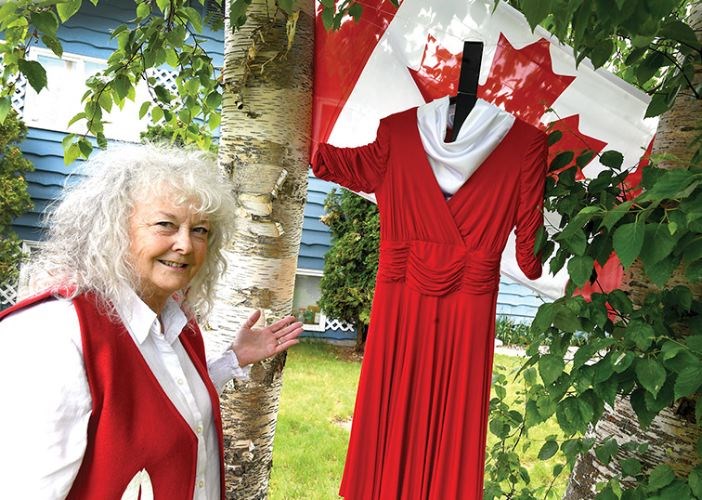Heather Potts is a fibre artist who knows the power of a dress. The First Nations clothing designer specializes in the colours black and red.
After the final report was released from the National Inquiry Into Missing and Murdered Indigenous Women and Girls, Potts felt moved to create. She was already well aware of the Red Dress Campaign (also known as the REDress Project), a visual touchstone across Canada that draws attention to the issue of too many female victims of violence. As someone who works with fabrics and fashions dresses, this billowed in her mind along with the personal grief she suffers.
It all blew out onto her front yard this week. Her Killarney Drive home is now a backdrop for a piece of public art, acting as a visual response.
"I have been thinking about this, turning it over in my mind, for quite some time," she said, and even purchased a red dress she saw one day that had the elegance she was looking for to accomplish her artistic purpose. "It finally came to me. I put the red dress out on a stand I had for displaying clothing. I put it between two birch trees. One arm is outstretched, lifted up to the Creator. The Canadian flag is wrapped behind her because Trudeau said he would help. I'm taking him at his word. He has to respond. The Canadians have suffered, too, not just First Nations. It's mostly First Nations victims, but not all, and it affects us all. We are all together in our suffering. We must be all together in solutions. I put all this out there, then lo and behold, I looked down and saw that it was all above some lily of the valley. Jesus has sometimes been symbolized by the lily of the valley, so I took that to mean Jesus was holding all of this up."
The public art expression has a mental meaning to Potts as an Indigenous elder and longtime fibre artist, but it also has a direct streak of pain that comes from her heart. Her niece Amber Potts-Jaffary was last seen in 1988 after a teenaged conflict with her parents. The Etobicoke teen flagged down a stranger for a ride, following a rebellious argument and was never again seen or heard of by her loved ones.
It happened right in the midst of a serial rapist spree in that same area that turned out to be perpetrated by Paul Bernardo. Was Potts-Jaffary one of this killer's victims?
Or, as in the case of the Highway of Tears experience, it is possible there were multiple predators at work.
"Both her father and her mother have passed on, now," said Potts. "She has been heavy in my heart. She was so young when she went missing, and it has been more than 30 years now."
The empty red dress represents the missing girl who would now be a woman in Potts' life, just as the red dresses all across Canada in the national campaign represent the shocking numbers of missing and murdered women and girls, all too predominantly Indigenous.
The project began in 2014 in Winnipeg by Metis multimedia artist Jaime Black who asked for 600 red dresses be donated to her creative vision that involved them being placed in numerous public spaces around that city, and beyond.
"It is an installation art project based on an aesthetic response to this critical national issue," said Black, who sought to establish an unforgettable "visual reminder of the staggering number of women who are no longer with us. Through the installation I hope to draw attention to the gendered and racialized nature of violent crimes against Aboriginal women and to evoke a presence through the marking of absence."
It was given nationwide life when it was taken on as an ongoing call to action by the Public Service Alliance of Canada.
Potts has given it its most personal and intimate voice here in Prince George. It was coincidental, said Potts, that the Prince George Fibre Arts Guild was hosting the Association of Northwest Weavers' Guilds conference here in this city, opening on the same day as her unveiling of the red dress. Potts considered it a happy accident that underscores the power of fibre, fabric and fashion to make statements on life's most important issues and concerns.

.png;w=120;h=80;mode=crop)

